

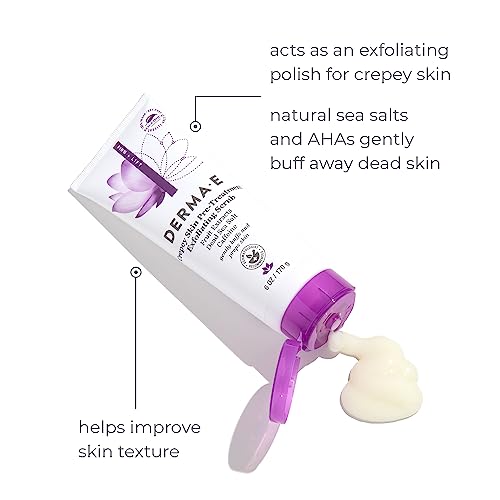
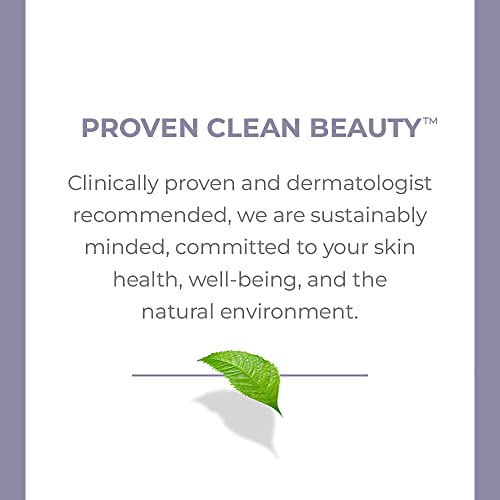
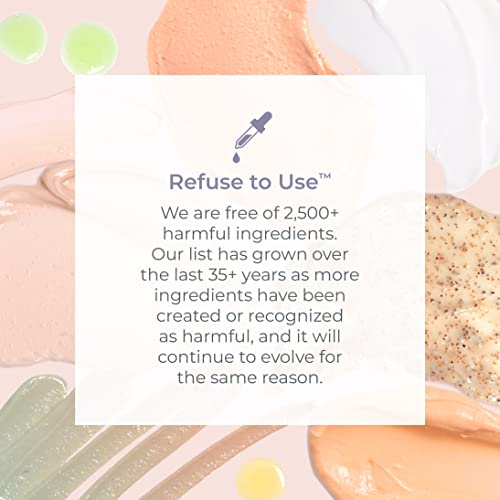
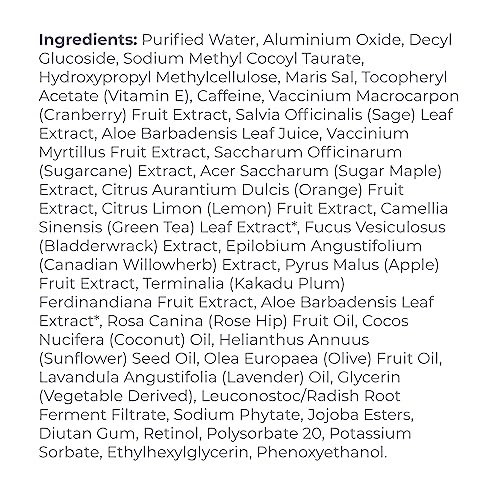
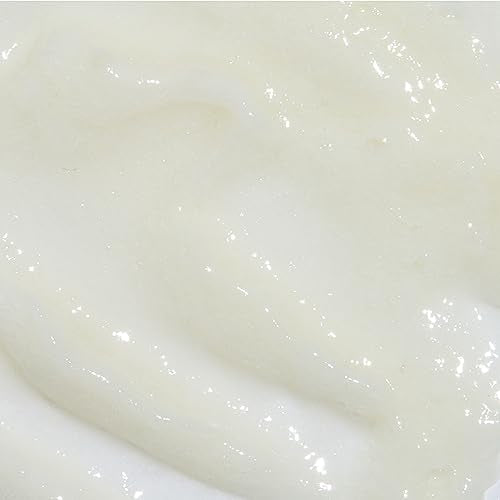
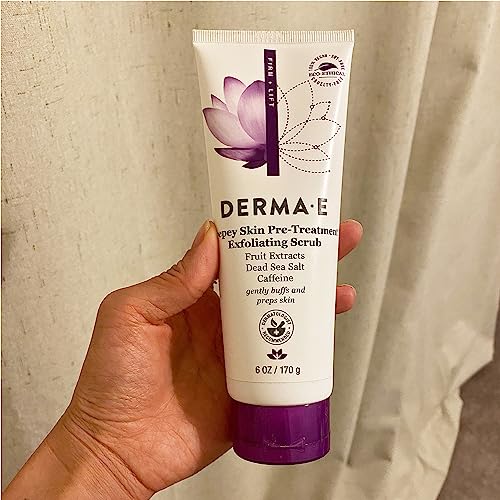
DERMA E Body Scrub - Softening Exfoliant with Kakadu Plum & Dead Sea Salts - 6 Oz


Retinol (Vitamin A)
High RiskRetinol (vitamin A) is a naturally occurring substance primarily known for its role in skin health, often included in products aimed at improving skin texture and reducing signs of aging. It functions as a potent ingredient in skincare formulations, enhancing cellular turnover and promoting collagen production.
Sustai Insights
Retinol offers functional benefits such as enhancing skin absorption and improving skin appearance through increased turnover and collagen synthesis. However, its usage is associated with high concerns regarding developmental and reproductive toxicity and potential irritation. Environmental risks include its contribution to pollution, while regulatory bodies impose strict usage restrictions. Overall, the risk level is assessed as high, necessitating careful consideration in its application and the exploration of safer alternatives.
Ci 77000
High RiskCI 77000, also known as aluminum powder, is a metallic substance commonly used as a color additive in cosmetics and personal care products. It imparts a metallic sheen and is often included in formulations for its aesthetic properties.
Sustai Insights
Aluminum powder serves effectively as a colorant, providing a distinctive metallic finish in cosmetic products. However, it is associated with high concerns regarding allergies and neurotoxicity, alongside potential adverse effects on skin and respiratory health. Regulatory bodies impose stringent usage restrictions due to these health risks, categorizing it as a high-risk ingredient overall. Users should consider safer alternatives or opt for products that do not contain aluminum powder, especially for sensitive applications.
Camellia Sinensis (Green Tea) Leaf Extract
Medium RiskCamellia sinensis (green tea) leaf extract is derived from the leaves of the Camellia sinensis plant, primarily known for its antioxidant properties. It is commonly used in cosmetic formulations for its potential to soothe the skin and provide protective benefits against environmental stressors.
Sustai Insights
Camellia sinensis leaf extract offers functional benefits, including antioxidant properties that may protect the skin from damage and enhance product efficacy. While generally regarded as safe, it presents moderate allergenic potential and low concerns for carcinogenic or reproductive toxicity. Environmental risks are minimal; however, the sourcing practices should be evaluated for sustainability. Regulatory bodies do not impose significant restrictions, indicating a low-risk profile overall. Safe usage practices are advisable, and alternatives include other botanical extracts with similar benefits.
Phenoxyethanol
Medium RiskPhenoxyethanol is a preservative used in cosmetics and personal care products to prevent microbial growth and extend shelf life. It is commonly found in formulations such as lotions, creams, and serums.
Sustai Insights
Phenoxyethanol serves effectively as a preservative, ensuring product stability and safety by inhibiting microbial growth. It is considered to have low health risks regarding carcinogenicity, allergies, and reproductive toxicity. However, moderate use restrictions exist, and regulatory bodies have advised caution in specific applications. Environmental concerns include its potential as a pollutant, although it is not highly bioaccumulative. Overall, the ingredient presents a medium risk level, with safe usage practices recommended and alternative preservatives available for those seeking greener options.
Potassium Sorbate
Medium RiskPotassium sorbate is a potassium salt of sorbic acid, primarily used as a preservative in food and cosmetic products. It inhibits the growth of molds, yeast, and some bacteria, extending the shelf life of products. It is commonly found in various formulations due to its effectiveness and low toxicity.
Sustai Insights
Potassium sorbate serves as an effective preservative, preventing microbial growth in food and cosmetic products, which is vital for safety and longevity. Although it has a low risk of carcinogenicity and developmental toxicity, there is a moderate concern regarding allergies and immunotoxicity. Environmentally, it poses minimal risks as it is not significantly bioaccumulative. Regulatory agencies have verified its use, although some products may face restrictions. Overall, it is assessed as a medium risk ingredient, with safe usage practices recommended, and alternatives such as natural preservatives could be considered.
Salvia Officinalis (Sage) Leaf Extract
Medium RiskSalvia officinalis (sage) leaf extract is derived from the leaves of the sage plant, commonly used in various cosmetic formulations. It serves primarily as an antioxidant and antimicrobial agent, contributing to product stability and skin health.
Sustai Insights
Sage leaf extract offers functional benefits such as antioxidant properties and antimicrobial effects, enhancing product efficacy. It is sustainably sourced; however, moderate concerns exist regarding potential allergic reactions. Health risks are generally low, with minimal concerns about carcinogenicity or reproductive toxicity. Regulatory status is favorable, with no current restrictions noted. Overall, the ingredient presents a medium risk profile, and safe usage practices should be observed. Alternatives may include other herbal extracts with similar properties.
Fucus Vesiculosus Extract
Medium RiskFucus vesiculosus extract is derived from the brown seaweed Fucus vesiculosus, commonly known as bladderwrack. It is often used in cosmetic and personal care products for its potential skin-soothing and moisturizing properties.
Sustai Insights
Fucus vesiculosus extract offers functional benefits as a moisturizer and potential antioxidant, contributing to skin hydration. It is considered low risk for cancer, allergies, and developmental toxicity, although it may pose low to moderate risks for endocrine disruption. Environmental concerns are minimal, with no significant pollutant or bioaccumulation potential. Regulatory scrutiny is low, but verified products have restricted claims. Overall, the ingredient has a medium risk profile, and users should practice caution, particularly in sensitive applications, while exploring sustainable alternatives when available.
Sodium Phytate
Low RiskSodium phytate is a complex sodium salt of phytic acid, primarily used in cosmetic formulations as a chelating agent. It helps to stabilize formulations by binding metal ions, which can improve product efficacy and shelf life.
Sustai Insights
Sodium phytate offers functional benefits by enhancing product stability and is considered to have low health risks, with no significant associations with carcinogenicity, allergies, or reproductive toxicity. Environmentally, it poses minimal risks, as it is not considered a pollutant or bioaccumulative. Regulatory status indicates no significant restrictions. Overall, the ingredient is assessed as low risk. However, users should practice safe usage and consider alternatives like other chelating agents if desired.
Aloe Barbadensis (Aloe Vera) Leaf Extract
Low RiskAloe vera leaf extract is produced from the succulent leaves of the Aloe barbadensis plant. It is commonly used in cosmetic formulations for its moisturizing and soothing properties, making it a popular ingredient in skincare and personal care products.
Sustai Insights
Aloe vera leaf extract offers several functional benefits, including hydration and skin soothing effects, which are well-supported by scientific literature. It is considered to have a low risk for common health concerns such as carcinogenicity, allergies, or reproductive toxicity. Environmentally, it poses minimal risks, with no significant pollutant potential or bioaccumulation reported. Regulatory bodies have not imposed major restrictions, although verified products should not contain certain contaminants. Overall, this ingredient is assessed as low risk, with safe usage practices and the availability of alternative soothing agents if desired.
Vaccinium Myrtillus (Bilberry) Fruit Extract
Low RiskVaccinium myrtillus (bilberry) fruit extract is an extract derived from the fruit of the bilberry plant, known for its antioxidant properties. It is commonly used in cosmetic and skincare products for its potential benefits to skin health and appearance.
Sustai Insights
Vaccinium myrtillus fruit extract offers functional benefits as an antioxidant, potentially enhancing skin appearance and health. It is generally regarded as safe with low risks for carcinogenicity, allergenic reactions, and reproductive toxicity. Environmental concerns are minimal, as it poses low bioaccumulation risk. Regulatory bodies have not placed significant restrictions on its use, indicating a low overall risk profile. For safety, it is recommended to be used in typical cosmetic concentrations, with no known safer alternatives identified.
Caffeine
Low RiskCaffeine is a heterocyclic organic compound commonly found in coffee, tea, and various other plants. It acts as a central nervous system stimulant, temporarily warding off drowsiness and restoring alertness. In cosmetic applications, it is often included for its purported benefits in enhancing skin absorption and reducing the appearance of puffiness.
Sustai Insights
Caffeine offers functional benefits such as enhancing skin absorption and providing a stimulating effect. It is generally regarded as safe with low concerns regarding carcinogenicity, allergies, or developmental toxicity. Environmental risks include potential bioaccumulation, though overall it poses low risk based on current scientific consensus. Regulatory bodies have minimal restrictions, but care should be taken regarding enhanced skin absorption. Alternatives may include other stimulants or natural extracts with similar properties. Overall, caffeine is assessed as low risk.
Cocos Nucifera (Coconut) Oil
Low RiskCocos Nucifera (Coconut) Oil is derived from the kernels of the coconut palm. It is primarily used in cosmetic formulations for its emollient and moisturizing properties, making it suitable for skin and hair care products.
Sustai Insights
Coconut oil serves as an effective moisturizer and emollient, promoting skin hydration and softness. It is sustainably sourced and biodegradable. Health risks are minimal, with low concerns regarding carcinogenicity, allergens, and reproductive toxicity. Environmental impact is also low, as it does not contribute significantly to pollution or bioaccumulation. Regulatory bodies have not issued restrictions on its use. Overall, coconut oil presents a low risk for health and environmental concerns, making it a safe ingredient in cosmetic products.
Ethylhexylglycerin
Low RiskEthylhexylglycerin is a glyceryl ether utilized primarily as a skin-conditioning agent and preservative in cosmetic formulations. It enhances the efficacy of preservatives and serves as a humectant, helping to retain moisture in the skin. This ingredient is commonly found in various personal care products.
Sustai Insights
Ethylhexylglycerin offers functional benefits as an effective preservative and skin-conditioning agent, contributing to product longevity and moisture retention. Health risks are generally low, with minor concerns regarding allergic contact dermatitis and irritant potential. Environmentally, it poses minimal risks, not being recognized as a pollutant or bioaccumulative. Regulatory bodies have imposed few restrictions, indicating its safety for use. Overall, its risk level is assessed as low, making it a viable option in cosmetic formulations. For those seeking alternatives, ingredients like propanediol may serve similar functions with potentially lower irritation profiles.
Helianthus Annuus (Sunflower) Seed
Low RiskHelianthus annuus (sunflower) seed is derived from the seeds of the sunflower plant and is commonly used in various cosmetic and personal care products. It serves primarily as an emollient and skin conditioning agent, providing moisture and enhancing the texture of formulations.
Sustai Insights
Helianthus annuus (sunflower) seed offers functional benefits, including skin conditioning and moisturizing properties, while being sustainably sourced and biodegradable. Health risks are minimal, with low concerns for carcinogenicity, allergies, and reproductive toxicity. Environmentally, it presents low risks of pollution or bioaccumulation. Regulatory assessments indicate no current restrictions. Overall, it is considered a low-risk ingredient, and safe usage practices should be maintained. Alternative ingredients may include other plant-based oils, but the sunflower seed oil remains a viable option.
Olea Europaea (Olive) Oil
Low RiskOlea europaea (olive) oil is derived from the ripe fruit of the olive tree. It is commonly used in cosmetic formulations primarily as a moisturizer and emollient due to its nourishing properties for the skin. It also serves as a carrier oil for other ingredients in formulations.
Sustai Insights
Olea europaea (olive) oil offers numerous functional benefits, including effective moisturization and enhanced skin absorption properties, making it suitable for various cosmetic applications. It is a biodegradable ingredient, contributing to sustainability when sourced responsibly. Health risks are low, with minimal concerns regarding carcinogenicity, allergenic potential, and developmental toxicity. Environmental risks are also low, with no significant bioaccumulation or pollution potential noted. Regulatory bodies do not impose restrictions on its use. Overall, olive oil presents a low risk profile, making it a favorable choice in cosmetic products.
Acer Saccharum (Sugar Maple) Extract
Low RiskAcer saccharum (sugar maple) extract is an extract derived from the sap of the sugar maple tree, traditionally used for its moisturizing and soothing properties in cosmetic formulations. It is often included in skincare products for its potential benefits in improving skin hydration and texture.
Sustai Insights
Acer saccharum extract offers functional benefits as a hydrating agent, contributing to skin moisture retention. It is generally considered low-risk regarding health impacts, with minimal concerns about carcinogenicity, allergies, or reproductive toxicity. Environmentally, it does not pose significant pollutant or bioaccumulation risks. Regulatory bodies have not issued restrictions on its use, affirming its safety profile. Overall, it is assessed as low risk, making it a viable ingredient in cosmetic products. Alternatives are limited, but other plant extracts may also provide similar hydrating benefits.
Citrus Limon (Lemon) Fruit Extract
Low RiskCitrus limon (lemon) fruit extract is derived from the fruit of the lemon tree, Citrus medica limonum. It is commonly used in cosmetic and personal care formulations for its fragrance and potential skin benefits.
Sustai Insights
Citrus limon extract offers functional benefits, including natural fragrance and potential antioxidant properties. It is generally considered safe, with low concerns regarding allergies, carcinogenicity, and reproductive toxicity. However, it may cause skin irritation in sensitive individuals. Environmentally, it poses low risks, as it is biodegradable and not bioaccumulative. Regulatory agencies do not impose significant restrictions on its use. Overall, the risk level for this ingredient is low, making it a favorable choice in formulations.
Sodium Methyl Cocoyl Taurate
Low RiskSodium methyl cocoyl taurate is a sodium salt derived from coconut fatty acids, primarily used as a mild surfactant and foaming agent in personal care products. It helps to cleanse and stabilize formulations, contributing to improved texture and performance.
Sustai Insights
Sodium methyl cocoyl taurate is recognized for its effective surfactant properties, providing gentle cleansing and foam production in formulations. It is considered low risk for health concerns such as carcinogenicity and allergenic potential, with minimal irritation noted. Environmentally, it poses low hazards with no significant bioaccumulation or pollution risks. Regulatory bodies, including ECHA, indicate no current restrictions. Overall, it presents a low risk profile, making it a viable choice in personal care applications. Safe usage practices are recommended, and alternatives may include other mild surfactants.
Jojoba Esters
Low RiskJojoba esters are a complex mixture of esters produced from the oil of the jojoba plant (Simmondsia chinensis). They serve primarily as emollients and skin conditioning agents in cosmetic formulations, enhancing texture and moisture retention.
Sustai Insights
Jojoba esters provide effective moisturizing properties, contributing to skin conditioning and improving product feel. They are sustainably sourced and biodegradable, posing low risk for carcinogenicity, allergies, and developmental toxicity. Environmental risks are minimal, with no significant pollutants or bioaccumulation concerns. Regulatory agencies have not imposed restrictions, indicating a low overall risk assessment. Safe usage practices should include monitoring for any allergic reactions, although such occurrences are rare. Alternatives, such as synthetic emollients, may be considered, but jojoba esters remain a low-risk option.
Pyrus Malus (Apple) Fruit Extract
Low RiskPyrus malus (apple) fruit extract is derived from the fruit of the apple tree and is commonly used in cosmetic formulations for its nourishing properties and potential skin benefits.
Sustai Insights
Pyrus malus (apple) fruit extract offers functional benefits such as antioxidant properties and skin conditioning. It is considered low risk for health concerns, including cancer, allergies, and reproductive toxicity. Environmentally, it poses minimal risks, being non-pollutant and non-bioaccumulative. Regulatory bodies do not impose significant restrictions on its use. Overall, it is deemed low risk, making it a suitable ingredient in cosmetic products. Safe usage practices should still be observed, and alternatives may include other fruit extracts for similar benefits.
Vegetarian Glycerin
Low RiskVegetarian glycerin, also known as glycerol, is a colorless, odorless, and viscous liquid derived from plant sources. It is primarily used as a humectant, solvent, and emollient in various personal care products, helping to retain moisture and improve texture.
Sustai Insights
Vegetarian glycerin offers functional benefits as an effective humectant, promoting hydration and skin smoothness. It is biodegradable and typically sustainably sourced. Health risks associated with glycerin are low, with no significant concerns for carcinogenicity, allergens, or reproductive toxicity. Environmental risks are minimal, and it is not subject to major regulatory warnings. Overall, the risk level for this ingredient is low, making it a safe choice in formulations. Safe usage practices include ensuring proper concentrations in products, and alternatives such as propylene glycol exist but may have differing properties.
Hydroxymethylcellulose
Low RiskHydroxymethylcellulose is a synthetic polymer derived from cellulose, primarily used as a thickening agent, emulsifier, and film-forming agent in various personal care and cosmetic products. It enhances texture, stability, and moisture retention, making it suitable for use in creams, lotions, and gels.
Sustai Insights
Hydroxymethylcellulose serves effectively as a thickener and stabilizer, contributing to product texture and moisture retention. It is considered low risk for health concerns such as carcinogenicity, allergies, and reproductive toxicity. Environmentally, it is not classified as a pollutant or bioaccumulative, aligning with regulatory standards in multiple regions. Overall, its risk level is assessed as low, with no significant adverse effects reported. Safe usage practices should be followed, and while alternatives exist, hydroxymethylcellulose remains a suitable choice in formulations.
Leuconostoc/Radish Root Ferment Filtrate
Low RiskLeuconostoc/radish root ferment filtrate is a natural fermentation product derived from radish roots, commonly used in skincare for its potential preservative properties and skin-conditioning benefits. It functions by harnessing the metabolic activity of Leuconostoc bacteria to provide a source of beneficial compounds.
Sustai Insights
This ingredient offers functional benefits, primarily as a preservative and skin-conditioning agent, while being biodegradable and sustainably sourced. Health risks are generally low, with no significant concerns regarding carcinogenicity or allergies, though contamination concerns exist. Environmentally, it poses minimal risks, categorized as low overall risk based on current scientific consensus. Safe usage practices are advised, and alternatives may include other natural preservatives like tocopherol or rosemary extract.
Polysorbate 21
Low RiskPolysorbate 21 is a mixture of laurate esters of sorbitol and its fatty acid esters, commonly used as an emulsifier and surfactant in cosmetic formulations. It helps to stabilize mixtures of oil and water, enhancing texture and consistency in products.
Sustai Insights
Polysorbate 21 serves effectively as an emulsifier, contributing to product stability and texture. It presents a low risk for health concerns such as carcinogenicity, allergies, and reproductive toxicity. Environmentally, it poses minimal hazards and is not known to bioaccumulate. Regulatory bodies, including the FDA, have not imposed significant restrictions on its use. Safe usage practices should be followed to minimize skin irritation. Overall, this ingredient is assessed as low risk with no notable adverse effects or significant environmental concerns.
Citrus Aurantium Dulcis (Orange) Fruit Extract
Low RiskCitrus aurantium dulcis (orange) fruit extract is derived from the fruit of the sweet orange tree, primarily utilized for its fragrance and potential antioxidant properties. It is commonly included in cosmetic and personal care products for its sensory attributes and may also have moisturizing effects.
Sustai Insights
Citrus aurantium dulcis (orange) fruit extract offers functional benefits such as fragrance enhancement and potential antioxidant properties. It is generally recognized as safe with low concerns regarding carcinogenicity, allergies, and reproductive toxicity. However, it may pose minimal environmental risks due to its sourcing. Regulatory bodies have not imposed significant restrictions, supporting its low-risk profile. Safe usage practices include avoiding contact with eyes. Alternatives may include other plant extracts for fragrance or antioxidant properties. Overall, this ingredient presents a low risk for health and environmental impacts.
Lavandula Angustifolia (Lavender) Flower Oil
Low RiskLavandula angustifolia (lavender) flower oil is an essential oil derived from the flowers of the lavender plant. It is commonly used in personal care products for its aromatic properties and is known for its potential soothing effects in formulations.
Sustai Insights
Lavender oil provides functional benefits such as fragrance enhancement and potential calming effects, contributing to user experience in various personal care products. It is sustainably sourced and has low toxicity levels. Health risks associated with lavender oil are minimal, with low concerns for carcinogenicity, allergies, and reproductive toxicity. Environmental risks are also low, with no significant pollutant concerns. Regulatory assessments indicate no current restrictions, affirming its safety for use. Overall, the ingredient is considered low risk, making it a favorable choice in formulations.
Decyl Glucoside
Low RiskDecyl glucoside is a glucose-based surfactant derived from natural sources, primarily used as a mild cleansing agent in personal care products. It effectively reduces surface tension, allowing for improved mixing of ingredients and enhanced cleansing properties without stripping natural oils from the skin.
Sustai Insights
Decyl glucoside offers functional benefits as a non-ionic surfactant, making it suitable for sensitive skin formulations. It is biodegradable and derived from renewable resources, supporting sustainability. Health risks are primarily low, with minimal concerns regarding irritation and allergies. Environmental risks are low, as it does not significantly contribute to pollution or bioaccumulation. Regulatory status is generally favorable, with low restrictions noted. Overall, decyl glucoside presents a low risk for use in consumer products, making it a suitable choice for gentle formulations.
Vaccinium Macrocarpon (Cranberry) Fruit Extract
Low RiskVaccinium macrocarpon (cranberry) fruit extract is derived from the fruit of the cranberry plant. It is commonly used in cosmetic and personal care products for its antioxidant properties and ability to provide moisture and nourishment to the skin.
Sustai Insights
Cranberry fruit extract offers functional benefits such as antioxidant protection and skin hydration, contributing positively to product efficacy. It is sustainably sourced and generally recognized as safe, presenting low health risks, including minimal concerns for carcinogenicity and irritation. Environmental impacts are low, with no significant pollutant or bioaccumulation concerns. Regulatory assessments indicate no restrictions. Overall, cranberry fruit extract is considered low risk, and safe usage practices involve normal cosmetic applications. Alternatives include other fruit extracts with similar benefits.
Sodium Phytate
Low RiskSodium phytate is a complex sodium salt of phytic acid, primarily used in cosmetic formulations as a chelating agent. It helps to stabilize formulations by binding metal ions, which can improve product efficacy and shelf life.
Sustai Insights
Sodium phytate offers functional benefits by enhancing product stability and is considered to have low health risks, with no significant associations with carcinogenicity, allergies, or reproductive toxicity. Environmentally, it poses minimal risks, as it is not considered a pollutant or bioaccumulative. Regulatory status indicates no significant restrictions. Overall, the ingredient is assessed as low risk. However, users should practice safe usage and consider alternatives like other chelating agents if desired.
Aloe Barbadensis (Aloe Vera) Leaf Extract
Low RiskAloe vera leaf extract is produced from the succulent leaves of the Aloe barbadensis plant. It is commonly used in cosmetic formulations for its moisturizing and soothing properties, making it a popular ingredient in skincare and personal care products.
Sustai Insights
Aloe vera leaf extract offers several functional benefits, including hydration and skin soothing effects, which are well-supported by scientific literature. It is considered to have a low risk for common health concerns such as carcinogenicity, allergies, or reproductive toxicity. Environmentally, it poses minimal risks, with no significant pollutant potential or bioaccumulation reported. Regulatory bodies have not imposed major restrictions, although verified products should not contain certain contaminants. Overall, this ingredient is assessed as low risk, with safe usage practices and the availability of alternative soothing agents if desired.
Vaccinium Myrtillus (Bilberry) Fruit Extract
Low RiskVaccinium myrtillus (bilberry) fruit extract is an extract derived from the fruit of the bilberry plant, known for its antioxidant properties. It is commonly used in cosmetic and skincare products for its potential benefits to skin health and appearance.
Sustai Insights
Vaccinium myrtillus fruit extract offers functional benefits as an antioxidant, potentially enhancing skin appearance and health. It is generally regarded as safe with low risks for carcinogenicity, allergenic reactions, and reproductive toxicity. Environmental concerns are minimal, as it poses low bioaccumulation risk. Regulatory bodies have not placed significant restrictions on its use, indicating a low overall risk profile. For safety, it is recommended to be used in typical cosmetic concentrations, with no known safer alternatives identified.
Caffeine
Low RiskCaffeine is a heterocyclic organic compound commonly found in coffee, tea, and various other plants. It acts as a central nervous system stimulant, temporarily warding off drowsiness and restoring alertness. In cosmetic applications, it is often included for its purported benefits in enhancing skin absorption and reducing the appearance of puffiness.
Sustai Insights
Caffeine offers functional benefits such as enhancing skin absorption and providing a stimulating effect. It is generally regarded as safe with low concerns regarding carcinogenicity, allergies, or developmental toxicity. Environmental risks include potential bioaccumulation, though overall it poses low risk based on current scientific consensus. Regulatory bodies have minimal restrictions, but care should be taken regarding enhanced skin absorption. Alternatives may include other stimulants or natural extracts with similar properties. Overall, caffeine is assessed as low risk.
Cocos Nucifera (Coconut) Oil
Low RiskCocos Nucifera (Coconut) Oil is derived from the kernels of the coconut palm. It is primarily used in cosmetic formulations for its emollient and moisturizing properties, making it suitable for skin and hair care products.
Sustai Insights
Coconut oil serves as an effective moisturizer and emollient, promoting skin hydration and softness. It is sustainably sourced and biodegradable. Health risks are minimal, with low concerns regarding carcinogenicity, allergens, and reproductive toxicity. Environmental impact is also low, as it does not contribute significantly to pollution or bioaccumulation. Regulatory bodies have not issued restrictions on its use. Overall, coconut oil presents a low risk for health and environmental concerns, making it a safe ingredient in cosmetic products.
Ethylhexylglycerin
Low RiskEthylhexylglycerin is a glyceryl ether utilized primarily as a skin-conditioning agent and preservative in cosmetic formulations. It enhances the efficacy of preservatives and serves as a humectant, helping to retain moisture in the skin. This ingredient is commonly found in various personal care products.
Sustai Insights
Ethylhexylglycerin offers functional benefits as an effective preservative and skin-conditioning agent, contributing to product longevity and moisture retention. Health risks are generally low, with minor concerns regarding allergic contact dermatitis and irritant potential. Environmentally, it poses minimal risks, not being recognized as a pollutant or bioaccumulative. Regulatory bodies have imposed few restrictions, indicating its safety for use. Overall, its risk level is assessed as low, making it a viable option in cosmetic formulations. For those seeking alternatives, ingredients like propanediol may serve similar functions with potentially lower irritation profiles.
Helianthus Annuus (Sunflower) Seed
Low RiskHelianthus annuus (sunflower) seed is derived from the seeds of the sunflower plant and is commonly used in various cosmetic and personal care products. It serves primarily as an emollient and skin conditioning agent, providing moisture and enhancing the texture of formulations.
Sustai Insights
Helianthus annuus (sunflower) seed offers functional benefits, including skin conditioning and moisturizing properties, while being sustainably sourced and biodegradable. Health risks are minimal, with low concerns for carcinogenicity, allergies, and reproductive toxicity. Environmentally, it presents low risks of pollution or bioaccumulation. Regulatory assessments indicate no current restrictions. Overall, it is considered a low-risk ingredient, and safe usage practices should be maintained. Alternative ingredients may include other plant-based oils, but the sunflower seed oil remains a viable option.
Olea Europaea (Olive) Oil
Low RiskOlea europaea (olive) oil is derived from the ripe fruit of the olive tree. It is commonly used in cosmetic formulations primarily as a moisturizer and emollient due to its nourishing properties for the skin. It also serves as a carrier oil for other ingredients in formulations.
Sustai Insights
Olea europaea (olive) oil offers numerous functional benefits, including effective moisturization and enhanced skin absorption properties, making it suitable for various cosmetic applications. It is a biodegradable ingredient, contributing to sustainability when sourced responsibly. Health risks are low, with minimal concerns regarding carcinogenicity, allergenic potential, and developmental toxicity. Environmental risks are also low, with no significant bioaccumulation or pollution potential noted. Regulatory bodies do not impose restrictions on its use. Overall, olive oil presents a low risk profile, making it a favorable choice in cosmetic products.
Acer Saccharum (Sugar Maple) Extract
Low RiskAcer saccharum (sugar maple) extract is an extract derived from the sap of the sugar maple tree, traditionally used for its moisturizing and soothing properties in cosmetic formulations. It is often included in skincare products for its potential benefits in improving skin hydration and texture.
Sustai Insights
Acer saccharum extract offers functional benefits as a hydrating agent, contributing to skin moisture retention. It is generally considered low-risk regarding health impacts, with minimal concerns about carcinogenicity, allergies, or reproductive toxicity. Environmentally, it does not pose significant pollutant or bioaccumulation risks. Regulatory bodies have not issued restrictions on its use, affirming its safety profile. Overall, it is assessed as low risk, making it a viable ingredient in cosmetic products. Alternatives are limited, but other plant extracts may also provide similar hydrating benefits.
Camellia Sinensis (Green Tea) Leaf Extract
Medium RiskCamellia sinensis (green tea) leaf extract is derived from the leaves of the Camellia sinensis plant, primarily known for its antioxidant properties. It is commonly used in cosmetic formulations for its potential to soothe the skin and provide protective benefits against environmental stressors.
Sustai Insights
Camellia sinensis leaf extract offers functional benefits, including antioxidant properties that may protect the skin from damage and enhance product efficacy. While generally regarded as safe, it presents moderate allergenic potential and low concerns for carcinogenic or reproductive toxicity. Environmental risks are minimal; however, the sourcing practices should be evaluated for sustainability. Regulatory bodies do not impose significant restrictions, indicating a low-risk profile overall. Safe usage practices are advisable, and alternatives include other botanical extracts with similar benefits.
Citrus Limon (Lemon) Fruit Extract
Low RiskCitrus limon (lemon) fruit extract is derived from the fruit of the lemon tree, Citrus medica limonum. It is commonly used in cosmetic and personal care formulations for its fragrance and potential skin benefits.
Sustai Insights
Citrus limon extract offers functional benefits, including natural fragrance and potential antioxidant properties. It is generally considered safe, with low concerns regarding allergies, carcinogenicity, and reproductive toxicity. However, it may cause skin irritation in sensitive individuals. Environmentally, it poses low risks, as it is biodegradable and not bioaccumulative. Regulatory agencies do not impose significant restrictions on its use. Overall, the risk level for this ingredient is low, making it a favorable choice in formulations.
Phenoxyethanol
Medium RiskPhenoxyethanol is a preservative used in cosmetics and personal care products to prevent microbial growth and extend shelf life. It is commonly found in formulations such as lotions, creams, and serums.
Sustai Insights
Phenoxyethanol serves effectively as a preservative, ensuring product stability and safety by inhibiting microbial growth. It is considered to have low health risks regarding carcinogenicity, allergies, and reproductive toxicity. However, moderate use restrictions exist, and regulatory bodies have advised caution in specific applications. Environmental concerns include its potential as a pollutant, although it is not highly bioaccumulative. Overall, the ingredient presents a medium risk level, with safe usage practices recommended and alternative preservatives available for those seeking greener options.
Sodium Methyl Cocoyl Taurate
Low RiskSodium methyl cocoyl taurate is a sodium salt derived from coconut fatty acids, primarily used as a mild surfactant and foaming agent in personal care products. It helps to cleanse and stabilize formulations, contributing to improved texture and performance.
Sustai Insights
Sodium methyl cocoyl taurate is recognized for its effective surfactant properties, providing gentle cleansing and foam production in formulations. It is considered low risk for health concerns such as carcinogenicity and allergenic potential, with minimal irritation noted. Environmentally, it poses low hazards with no significant bioaccumulation or pollution risks. Regulatory bodies, including ECHA, indicate no current restrictions. Overall, it presents a low risk profile, making it a viable choice in personal care applications. Safe usage practices are recommended, and alternatives may include other mild surfactants.
Potassium Sorbate
Medium RiskPotassium sorbate is a potassium salt of sorbic acid, primarily used as a preservative in food and cosmetic products. It inhibits the growth of molds, yeast, and some bacteria, extending the shelf life of products. It is commonly found in various formulations due to its effectiveness and low toxicity.
Sustai Insights
Potassium sorbate serves as an effective preservative, preventing microbial growth in food and cosmetic products, which is vital for safety and longevity. Although it has a low risk of carcinogenicity and developmental toxicity, there is a moderate concern regarding allergies and immunotoxicity. Environmentally, it poses minimal risks as it is not significantly bioaccumulative. Regulatory agencies have verified its use, although some products may face restrictions. Overall, it is assessed as a medium risk ingredient, with safe usage practices recommended, and alternatives such as natural preservatives could be considered.
Jojoba Esters
Low RiskJojoba esters are a complex mixture of esters produced from the oil of the jojoba plant (Simmondsia chinensis). They serve primarily as emollients and skin conditioning agents in cosmetic formulations, enhancing texture and moisture retention.
Sustai Insights
Jojoba esters provide effective moisturizing properties, contributing to skin conditioning and improving product feel. They are sustainably sourced and biodegradable, posing low risk for carcinogenicity, allergies, and developmental toxicity. Environmental risks are minimal, with no significant pollutants or bioaccumulation concerns. Regulatory agencies have not imposed restrictions, indicating a low overall risk assessment. Safe usage practices should include monitoring for any allergic reactions, although such occurrences are rare. Alternatives, such as synthetic emollients, may be considered, but jojoba esters remain a low-risk option.
Retinol (Vitamin A)
High RiskRetinol (vitamin A) is a naturally occurring substance primarily known for its role in skin health, often included in products aimed at improving skin texture and reducing signs of aging. It functions as a potent ingredient in skincare formulations, enhancing cellular turnover and promoting collagen production.
Sustai Insights
Retinol offers functional benefits such as enhancing skin absorption and improving skin appearance through increased turnover and collagen synthesis. However, its usage is associated with high concerns regarding developmental and reproductive toxicity and potential irritation. Environmental risks include its contribution to pollution, while regulatory bodies impose strict usage restrictions. Overall, the risk level is assessed as high, necessitating careful consideration in its application and the exploration of safer alternatives.
Pyrus Malus (Apple) Fruit Extract
Low RiskPyrus malus (apple) fruit extract is derived from the fruit of the apple tree and is commonly used in cosmetic formulations for its nourishing properties and potential skin benefits.
Sustai Insights
Pyrus malus (apple) fruit extract offers functional benefits such as antioxidant properties and skin conditioning. It is considered low risk for health concerns, including cancer, allergies, and reproductive toxicity. Environmentally, it poses minimal risks, being non-pollutant and non-bioaccumulative. Regulatory bodies do not impose significant restrictions on its use. Overall, it is deemed low risk, making it a suitable ingredient in cosmetic products. Safe usage practices should still be observed, and alternatives may include other fruit extracts for similar benefits.
Salvia Officinalis (Sage) Leaf Extract
Medium RiskSalvia officinalis (sage) leaf extract is derived from the leaves of the sage plant, commonly used in various cosmetic formulations. It serves primarily as an antioxidant and antimicrobial agent, contributing to product stability and skin health.
Sustai Insights
Sage leaf extract offers functional benefits such as antioxidant properties and antimicrobial effects, enhancing product efficacy. It is sustainably sourced; however, moderate concerns exist regarding potential allergic reactions. Health risks are generally low, with minimal concerns about carcinogenicity or reproductive toxicity. Regulatory status is favorable, with no current restrictions noted. Overall, the ingredient presents a medium risk profile, and safe usage practices should be observed. Alternatives may include other herbal extracts with similar properties.
Vegetarian Glycerin
Low RiskVegetarian glycerin, also known as glycerol, is a colorless, odorless, and viscous liquid derived from plant sources. It is primarily used as a humectant, solvent, and emollient in various personal care products, helping to retain moisture and improve texture.
Sustai Insights
Vegetarian glycerin offers functional benefits as an effective humectant, promoting hydration and skin smoothness. It is biodegradable and typically sustainably sourced. Health risks associated with glycerin are low, with no significant concerns for carcinogenicity, allergens, or reproductive toxicity. Environmental risks are minimal, and it is not subject to major regulatory warnings. Overall, the risk level for this ingredient is low, making it a safe choice in formulations. Safe usage practices include ensuring proper concentrations in products, and alternatives such as propylene glycol exist but may have differing properties.
Fucus Vesiculosus Extract
Medium RiskFucus vesiculosus extract is derived from the brown seaweed Fucus vesiculosus, commonly known as bladderwrack. It is often used in cosmetic and personal care products for its potential skin-soothing and moisturizing properties.
Sustai Insights
Fucus vesiculosus extract offers functional benefits as a moisturizer and potential antioxidant, contributing to skin hydration. It is considered low risk for cancer, allergies, and developmental toxicity, although it may pose low to moderate risks for endocrine disruption. Environmental concerns are minimal, with no significant pollutant or bioaccumulation potential. Regulatory scrutiny is low, but verified products have restricted claims. Overall, the ingredient has a medium risk profile, and users should practice caution, particularly in sensitive applications, while exploring sustainable alternatives when available.
Hydroxymethylcellulose
Low RiskHydroxymethylcellulose is a synthetic polymer derived from cellulose, primarily used as a thickening agent, emulsifier, and film-forming agent in various personal care and cosmetic products. It enhances texture, stability, and moisture retention, making it suitable for use in creams, lotions, and gels.
Sustai Insights
Hydroxymethylcellulose serves effectively as a thickener and stabilizer, contributing to product texture and moisture retention. It is considered low risk for health concerns such as carcinogenicity, allergies, and reproductive toxicity. Environmentally, it is not classified as a pollutant or bioaccumulative, aligning with regulatory standards in multiple regions. Overall, its risk level is assessed as low, with no significant adverse effects reported. Safe usage practices should be followed, and while alternatives exist, hydroxymethylcellulose remains a suitable choice in formulations.
Leuconostoc/Radish Root Ferment Filtrate
Low RiskLeuconostoc/radish root ferment filtrate is a natural fermentation product derived from radish roots, commonly used in skincare for its potential preservative properties and skin-conditioning benefits. It functions by harnessing the metabolic activity of Leuconostoc bacteria to provide a source of beneficial compounds.
Sustai Insights
This ingredient offers functional benefits, primarily as a preservative and skin-conditioning agent, while being biodegradable and sustainably sourced. Health risks are generally low, with no significant concerns regarding carcinogenicity or allergies, though contamination concerns exist. Environmentally, it poses minimal risks, categorized as low overall risk based on current scientific consensus. Safe usage practices are advised, and alternatives may include other natural preservatives like tocopherol or rosemary extract.
Polysorbate 21
Low RiskPolysorbate 21 is a mixture of laurate esters of sorbitol and its fatty acid esters, commonly used as an emulsifier and surfactant in cosmetic formulations. It helps to stabilize mixtures of oil and water, enhancing texture and consistency in products.
Sustai Insights
Polysorbate 21 serves effectively as an emulsifier, contributing to product stability and texture. It presents a low risk for health concerns such as carcinogenicity, allergies, and reproductive toxicity. Environmentally, it poses minimal hazards and is not known to bioaccumulate. Regulatory bodies, including the FDA, have not imposed significant restrictions on its use. Safe usage practices should be followed to minimize skin irritation. Overall, this ingredient is assessed as low risk with no notable adverse effects or significant environmental concerns.
Citrus Aurantium Dulcis (Orange) Fruit Extract
Low RiskCitrus aurantium dulcis (orange) fruit extract is derived from the fruit of the sweet orange tree, primarily utilized for its fragrance and potential antioxidant properties. It is commonly included in cosmetic and personal care products for its sensory attributes and may also have moisturizing effects.
Sustai Insights
Citrus aurantium dulcis (orange) fruit extract offers functional benefits such as fragrance enhancement and potential antioxidant properties. It is generally recognized as safe with low concerns regarding carcinogenicity, allergies, and reproductive toxicity. However, it may pose minimal environmental risks due to its sourcing. Regulatory bodies have not imposed significant restrictions, supporting its low-risk profile. Safe usage practices include avoiding contact with eyes. Alternatives may include other plant extracts for fragrance or antioxidant properties. Overall, this ingredient presents a low risk for health and environmental impacts.
Ci 77000
High RiskCI 77000, also known as aluminum powder, is a metallic substance commonly used as a color additive in cosmetics and personal care products. It imparts a metallic sheen and is often included in formulations for its aesthetic properties.
Sustai Insights
Aluminum powder serves effectively as a colorant, providing a distinctive metallic finish in cosmetic products. However, it is associated with high concerns regarding allergies and neurotoxicity, alongside potential adverse effects on skin and respiratory health. Regulatory bodies impose stringent usage restrictions due to these health risks, categorizing it as a high-risk ingredient overall. Users should consider safer alternatives or opt for products that do not contain aluminum powder, especially for sensitive applications.
Lavandula Angustifolia (Lavender) Flower Oil
Low RiskLavandula angustifolia (lavender) flower oil is an essential oil derived from the flowers of the lavender plant. It is commonly used in personal care products for its aromatic properties and is known for its potential soothing effects in formulations.
Sustai Insights
Lavender oil provides functional benefits such as fragrance enhancement and potential calming effects, contributing to user experience in various personal care products. It is sustainably sourced and has low toxicity levels. Health risks associated with lavender oil are minimal, with low concerns for carcinogenicity, allergies, and reproductive toxicity. Environmental risks are also low, with no significant pollutant concerns. Regulatory assessments indicate no current restrictions, affirming its safety for use. Overall, the ingredient is considered low risk, making it a favorable choice in formulations.
Decyl Glucoside
Low RiskDecyl glucoside is a glucose-based surfactant derived from natural sources, primarily used as a mild cleansing agent in personal care products. It effectively reduces surface tension, allowing for improved mixing of ingredients and enhanced cleansing properties without stripping natural oils from the skin.
Sustai Insights
Decyl glucoside offers functional benefits as a non-ionic surfactant, making it suitable for sensitive skin formulations. It is biodegradable and derived from renewable resources, supporting sustainability. Health risks are primarily low, with minimal concerns regarding irritation and allergies. Environmental risks are low, as it does not significantly contribute to pollution or bioaccumulation. Regulatory status is generally favorable, with low restrictions noted. Overall, decyl glucoside presents a low risk for use in consumer products, making it a suitable choice for gentle formulations.
Vaccinium Macrocarpon (Cranberry) Fruit Extract
Low RiskVaccinium macrocarpon (cranberry) fruit extract is derived from the fruit of the cranberry plant. It is commonly used in cosmetic and personal care products for its antioxidant properties and ability to provide moisture and nourishment to the skin.
Sustai Insights
Cranberry fruit extract offers functional benefits such as antioxidant protection and skin hydration, contributing positively to product efficacy. It is sustainably sourced and generally recognized as safe, presenting low health risks, including minimal concerns for carcinogenicity and irritation. Environmental impacts are low, with no significant pollutant or bioaccumulation concerns. Regulatory assessments indicate no restrictions. Overall, cranberry fruit extract is considered low risk, and safe usage practices involve normal cosmetic applications. Alternatives include other fruit extracts with similar benefits.
Experience the transformative power of the DERMA E Crepey Skin Pre-Treatment Exfoliating Scrub. This antioxidant-rich body scrub is specially formulated to gently exfoliate dry, crepey skin, revealing a smoother, firmer appearance. Ideal for those seeking a natural skincare solution, this scrub utilizes a unique Anti-Crepe Complex featuring Kakadu Plum, Cranberry, and Apple Extracts, along with Dead Sea Salts to buff away dead skin cells.
- Gentle Exfoliation: Effectively removes dead skin cells, prepping skin for treatment and enhancing texture.
- Antioxidant-Rich Formula: Vitamins A and E nourish aging skin, promoting a youthful glow.
- Natural Ingredients: Infused with plant extracts and essential oils, it’s free from parabens, sulfates, and toxins.
- Daily Use: Incorporate into your routine 2-3 times a week for optimal results, focusing on areas prone to dryness.
- Eco-Friendly: 100% vegan and cruelty-free, supporting ethical beauty and sustainability.
Transform your skincare routine with this effective and eco-conscious body scrub.
Subscribe & Save with Sustai
- Best Price Guarantee: Always enjoy the lowest prices on sustainable home essentials.
- No Surprises: We’ll notify you before shipping. No hidden fees, ever.
- You’re in Charge: Change, pause, or cancel your subscription anytime with ease.
- Eco-Friendly Deliveries: Our grouped shipments mean less packaging and lower emissions.
Join us on a sustainable journey. Special offers for a limited time! Prices and promotions may change.
Recommended Products
Experience the transformative power of the DERMA E Crepey Skin Pre-Treatment Exfoliating Scrub. This antioxidant-rich body scrub is specially formulated to gently exfoliate dry, crepey skin, revealing a smoother, firmer appearance. Ideal for those seeking a natural skincare solution, this scrub utilizes a unique Anti-Crepe Complex featuring Kakadu Plum, Cranberry, and Apple Extracts, along with Dead Sea Salts to buff away dead skin cells.
- Gentle Exfoliation: Effectively removes dead skin cells, prepping skin for treatment and enhancing texture.
- Antioxidant-Rich Formula: Vitamins A and E nourish aging skin, promoting a youthful glow.
- Natural Ingredients: Infused with plant extracts and essential oils, it’s free from parabens, sulfates, and toxins.
- Daily Use: Incorporate into your routine 2-3 times a week for optimal results, focusing on areas prone to dryness.
- Eco-Friendly: 100% vegan and cruelty-free, supporting ethical beauty and sustainability.
Transform your skincare routine with this effective and eco-conscious body scrub.

You can have at most 2 Sustainable Steals products in your cart
Customer Reviews
Customers’ View
Customers generally appreciate the gentle exfoliation and the smoothing effects of this body scrub, noting improvements in skin texture. One user mentioned, 'My skin is silky smooth again,' highlighting the scrub's effectiveness. The product's natural ingredients, including Kakadu Plum and Cranberry, resonate well with health-conscious consumers, reinforcing a commitment to clean beauty. Additionally, users find the scrub suitable for regular use, contributing to a refreshed and rejuvenated appearance. While some customers expressed a desire for a more abrasive texture, the overall sentiment reflects satisfaction with its performance and alignment with eco-friendly values. Overall, this body scrub is seen as a beneficial addition to a sustainable personal care routine.
AI-generated from the text of customer reviewsThis product has no reviews yet.




